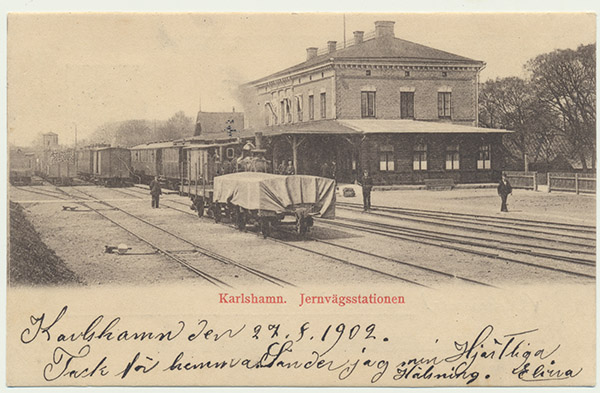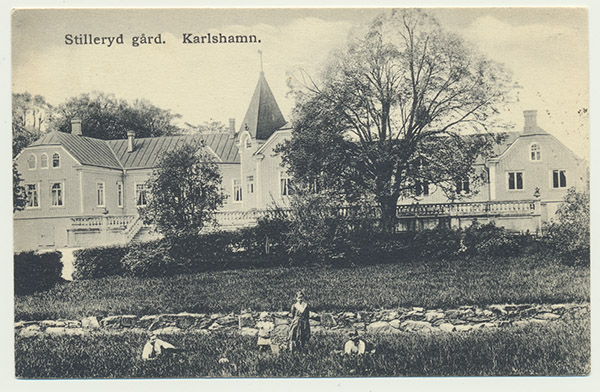
L. O. Smith’s many businesses: from railways to large-scale agriculture
L. O. Smith has gone down in history as the brännvin king. But spirits were not the only thing he was interested in. Strategically, L. O. Smith built up a range of peripheral activities: everything from large-scale agriculture to stone masonries.
Brännvin was the cornerstone of his business empire. But L. O. Smith was a versatile entrepreneur who aspired to bring together various industries. Among other things, he invested in maritime transport, railways and other infrastructure. Smith’s large distillery in Karlshamn provided him with a strong incentive to build the Västra Blekinge railway between Karlshamn and Sölvesborg, which opened in 1886.

Became a major farmer
L. O. Smith was also interested in that most classic of businesses: he became a major farmer early on. During the 19th century, Swedish agriculture was seen as the business of the future, despite the fact that more and more people were being employed by the industrial sector. The vision was for more efficient agriculture to provide more nutritious food and feed the growing urban population, as well as satisfy the high demand for animal feed. In addition, agriculture provided the raw ingredients for brännvin in the form of potatoes and grain.
In 1866, L. O. Smith acquired the Skälby gård manor farm in Bred parish between Enköping and Västerås. It was a large estate with several properties totalling about 2,800 hectares, much of which was particularly good arable land. At the beginning of his time there, Smith also had a distillery built on the property. Smith ran Skälby as a large farm until 1880.
Farming in his home region
Smith then returned to his home region of Blekinge and started developing large-scale agriculture on the Stilleryd farm just west of Karlshamn. The farm had been run by his foster father, Consul Carl Smith. After Carl Smith’s death, the farm was taken over by his son Gustaf Smith, who, however, declared himself unable to run the farm due to illness in 1881 and allowed L. O. Smith to take over the helm. With Stilleryd as his residence, he immediately embarked on a venture that would lead to the opening of the large distillery on the western quay in Karlshamn in 1884. The factory was the prominent project, but also brought a boost for Smith’s ancillary activities.
Smith developed Stilleryd farm, of which he formally became the owner in 1886. He purchased more land and also introduced a garden culture by planting 800 fruit trees on the farm. That became the foundation for a market garden that was run for around 60 years. L. O. Smith also built a park east of the main building and in 1888 hired an experienced master gardener from Finland, Johan Erik Rundqvist. Smith, however, was not involved in day-to-day operations. Instead the agricultural work was outsourced and managed by a tenant or steward.
Stilleryd farm experienced its heyday during L. O. Smith’s days. At one time, about 300 people were employed there. Employees ranged from foremen, maids, coachmen och farmhands to coopers, clerks, engineers, caretakers, stonemasons and workers. Many came from other parts of Sweden, as well as from Germany and Denmark.
One of the new industries to develop was the manufacture of barrels for the new distillery. The idea came from the young engineer Axel Tengvall, who then travelled with L. O. Smith’s son to the United States. Later Axel Tengvall was recruited as the manager when the distillery under Otto Smith’s leadership was converted into a sugar refinery.
A large farm that disappeared
Stilleryd farm was taken over in 1898 by Axel Tengvall and his family, who lived there for a few generations. However, towards the mid-20th century, the conditions for running a farm deteriorated, while what was then the municipality of Asarum indicated that the location was a suitable one for the development of large-scale port operations. In 1965, the municipality bought the property, and the old Stilleryd farm with its legacy from L. O. Smith was transformed into one of Sweden’s largest industrial ports.
Quarrying in Blekinge
L. O. Smith also saw the potential of quarrying. He invested in quarries both in Stilleryd and on nearby Sternö. The quarrying rights on Sternö were originally owned by Olof Gummesson Berg. Smith purchased the rights at a bankruptcy auction and began quarrying large paving stones. The company was given the name AB Karlshälls granitindustri. L. O. Smith quickly transferred management of the company to his son Carl Gustaf (Charley) Smith. The paving industry peaked around the start of the 20th century, but suffered as a result of competition from asphalt and cement concrete, which were introduced in earnest in the 1930s.
The granite from Blekinge was highly sought after and several famous buildings around the world are clad in stone blocks from Sternö Blåberg, for example the pillars along Stockholm City Hall and the façade of the Empire State Building in New York. However, the famous blue rock was not quarried by L. O. Smith’s company, but belonged to Alfred Kofoed Fernström, who also built up a major industry on Sternö.
Today, stone is no longer quarried on Sternö. Following soil decontamination, hundreds of new homes are instead planned for an attractive waterside development in a location that is still characterised by the historic legacy of L. O. Smith’s days.
